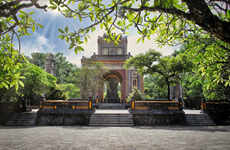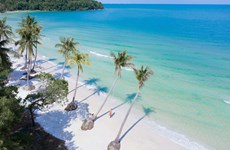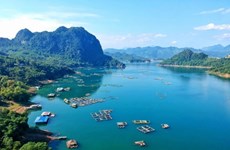Ha Giang posses way to Heaven's Gate
In my eyes, Ha Giang, the northernmost province of Vietnam , is
the most attractive destination in the country, with the rocky plateau
at Dong Van, the love market at Khau Vai, Heaven's Gate over the Quan
Ba Pass and the friendly, colourful ethnic groups.
In my eyes, Ha Giang, the northernmost province of Vietnam , is
the most attractive destination in the country, with the rocky plateau
at Dong Van, the love market at Khau Vai, Heaven's Gate over the Quan
Ba Pass and the friendly, colourful ethnic groups. For that
reason, despite the bad weather and narrow roads, our seven-day trip to
Ha Giang was eagerly anticipated.
The rocky, limestone district of Quan Ba was our second stop after Hoang Su Phi.
Located 320km to the north of Hanoi on the border with China , the district at an elevation of 1,000m above sea level and with its fresh, cool climate, typifies the beauty of Ha Giang. From there, we set out for the Quan Ba Pass and Heaven's Gate. The imposing, formidable landscape had us in awe as our car snaked along the treacherous roads, clinging to the side of the mountain. With a sheer drop on one side and cliffs rising up into the clouds on the other, it was as if God had chalked a line across the harsh terrain.
Reaching Heaven's Gate, the mist enveloped us, and the biting breeze rushed into the car as soon as the door was opened. The temperature in the early morning was very cold, even though we were wearing warm clothes.
Heaven's Gate is about 1,500m above sea level, and in 1939, the French built a stone wall and a wooden gate to block the pass, in order to prevent access to the Dong Van plateau and beyond. From the top of the mountain pass, we looked down across a large valley of unending terraced fields, displaying a charming beauty like a paradise dimly visible through the clouds. They carpet the ground in a patchwork of yellow rice, green shoots and brown mountain earth, with small houses nestled in between.
Standing out from this colourful valley is Twin Mountain , certified as a national heritage site by the Ministry of Culture, Sports and Tourism last year.
Its twin peaks rise up like the breasts of a giant woman, lying on the valley floor. The mountain is truly a product of leaching and erosion, combined with tectonic movement from a fault line below that last occurred around 5 million years ago. In actual fact, Quan Ba boasts an extensive karst landscape, but many regard Twin Mountain as its most beautiful feature, due to its picturesque setting.
We ventured down to Quyet Tien Commune, where the weather is very cool. With its temperate climate and fertile soil, locals can grow vegetables such as kohlrabi, cabbages, mustard greens, tomatoes and potatoes, as well as flowers including roses, daisies and violets, that they sell in the town.
We caught snatches of conversation from the locals as they worked happily in the fields.
We stopped one farmer, and asked her about her livelihood, and she blushed with embarrassment.
"My family used to grow rice, but now we grow high-quality vegetables and flowers. Thanks to this, my family's income has increased significantly," said Vang Thi May from Vinh Tien Hamlet.
Heading to Lung Tam Commune over the rolling hills and bumpy roads, we saw a valley of lush, green flax. This kind of plant provides the main raw material for brocade weaving. The village has a long-standing tradition of brocade weaving that contributes to preserving the traditional culture of the Mong who live in the area.
Around the Hop Tien Flax Weaving Co-operative established in the village in 2001, clanking sounds emanate from the looms and sewing machines.
The organisation started with 20 members, but today, 110 members each enjoy an average income of 1 million VND (48 USD) per month.
The co-operative now has 120 looms with products exported to 20 countries including France , Italy , the US , Japan , Germany and Denmark , following orders from export companies in Hanoi .
"I am very impressed with the local products, not only with the traditional patterns and colours, but also the diversity of what's on offer," said American Bill Savage, adding that he had bought handbags, purses and hats to give to his relatives as souvenirs of his time in Ha Giang.
Vang Thi Mai, 48, chairwoman of the Hop Tien Co-operative, said: "The Mong in Lung Tam are very happy now and have peace of mind, having restored and successfully developed their traditional handicraft, and shared it with visitors from home and abroad."
Leaving Lung Tam in the afternoon, we felt a little happier that the residents were finding a way to work their way out of poverty, but despite all this, the remote rocky environment makes life hard for the 7,000 households of various ethnic groups – Mong, Dao, Tay, Nung, Giay and Pu Y – who live there, and Quan Ba remains one of the poorest districts in Vietnam./.
The rocky, limestone district of Quan Ba was our second stop after Hoang Su Phi.
Located 320km to the north of Hanoi on the border with China , the district at an elevation of 1,000m above sea level and with its fresh, cool climate, typifies the beauty of Ha Giang. From there, we set out for the Quan Ba Pass and Heaven's Gate. The imposing, formidable landscape had us in awe as our car snaked along the treacherous roads, clinging to the side of the mountain. With a sheer drop on one side and cliffs rising up into the clouds on the other, it was as if God had chalked a line across the harsh terrain.
Reaching Heaven's Gate, the mist enveloped us, and the biting breeze rushed into the car as soon as the door was opened. The temperature in the early morning was very cold, even though we were wearing warm clothes.
Heaven's Gate is about 1,500m above sea level, and in 1939, the French built a stone wall and a wooden gate to block the pass, in order to prevent access to the Dong Van plateau and beyond. From the top of the mountain pass, we looked down across a large valley of unending terraced fields, displaying a charming beauty like a paradise dimly visible through the clouds. They carpet the ground in a patchwork of yellow rice, green shoots and brown mountain earth, with small houses nestled in between.
Standing out from this colourful valley is Twin Mountain , certified as a national heritage site by the Ministry of Culture, Sports and Tourism last year.
Its twin peaks rise up like the breasts of a giant woman, lying on the valley floor. The mountain is truly a product of leaching and erosion, combined with tectonic movement from a fault line below that last occurred around 5 million years ago. In actual fact, Quan Ba boasts an extensive karst landscape, but many regard Twin Mountain as its most beautiful feature, due to its picturesque setting.
We ventured down to Quyet Tien Commune, where the weather is very cool. With its temperate climate and fertile soil, locals can grow vegetables such as kohlrabi, cabbages, mustard greens, tomatoes and potatoes, as well as flowers including roses, daisies and violets, that they sell in the town.
We caught snatches of conversation from the locals as they worked happily in the fields.
We stopped one farmer, and asked her about her livelihood, and she blushed with embarrassment.
"My family used to grow rice, but now we grow high-quality vegetables and flowers. Thanks to this, my family's income has increased significantly," said Vang Thi May from Vinh Tien Hamlet.
Heading to Lung Tam Commune over the rolling hills and bumpy roads, we saw a valley of lush, green flax. This kind of plant provides the main raw material for brocade weaving. The village has a long-standing tradition of brocade weaving that contributes to preserving the traditional culture of the Mong who live in the area.
Around the Hop Tien Flax Weaving Co-operative established in the village in 2001, clanking sounds emanate from the looms and sewing machines.
The organisation started with 20 members, but today, 110 members each enjoy an average income of 1 million VND (48 USD) per month.
The co-operative now has 120 looms with products exported to 20 countries including France , Italy , the US , Japan , Germany and Denmark , following orders from export companies in Hanoi .
"I am very impressed with the local products, not only with the traditional patterns and colours, but also the diversity of what's on offer," said American Bill Savage, adding that he had bought handbags, purses and hats to give to his relatives as souvenirs of his time in Ha Giang.
Vang Thi Mai, 48, chairwoman of the Hop Tien Co-operative, said: "The Mong in Lung Tam are very happy now and have peace of mind, having restored and successfully developed their traditional handicraft, and shared it with visitors from home and abroad."
Leaving Lung Tam in the afternoon, we felt a little happier that the residents were finding a way to work their way out of poverty, but despite all this, the remote rocky environment makes life hard for the 7,000 households of various ethnic groups – Mong, Dao, Tay, Nung, Giay and Pu Y – who live there, and Quan Ba remains one of the poorest districts in Vietnam./.













